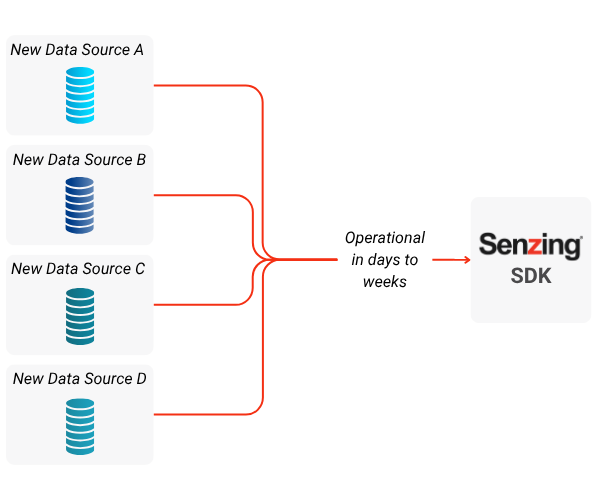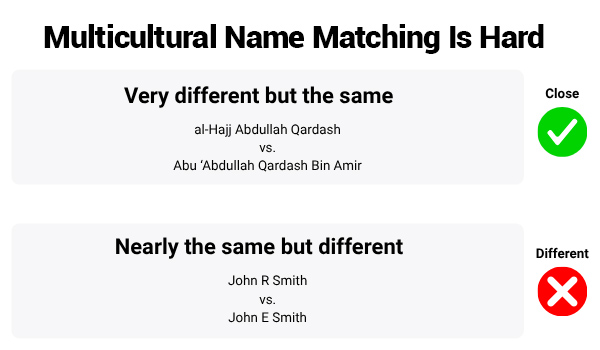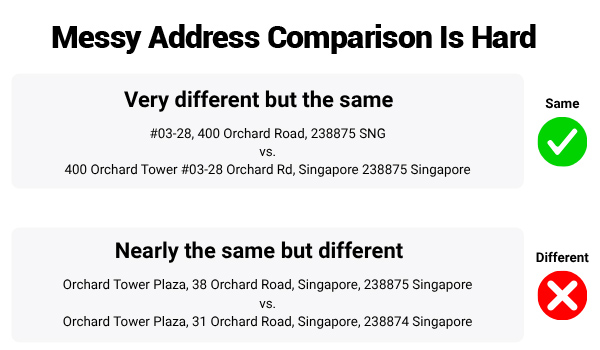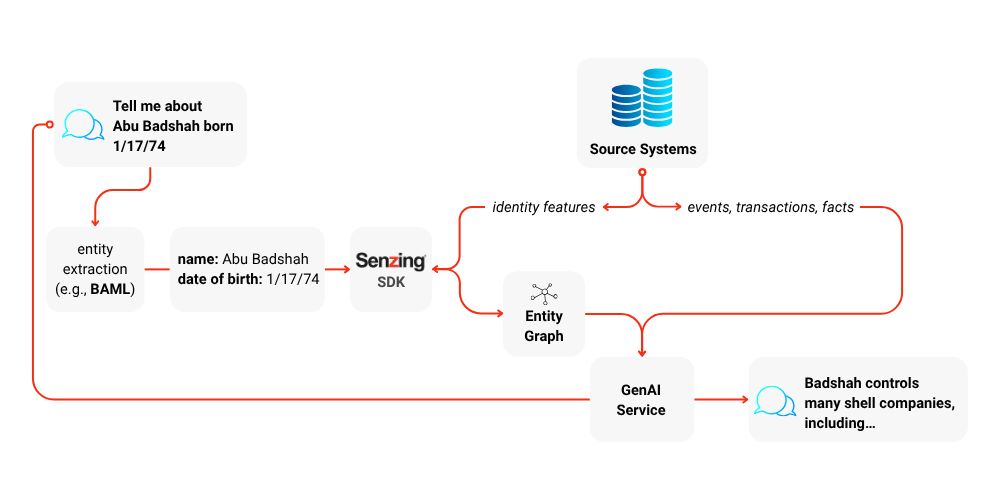Senzing Entity Resolution as a Sidecar or in Parallel:
Don't Rip & Replace Your Entity Resolution – Upgrade In Place
Using Senzing as a sidecar or in parallel you can augment your existing entity resolution investment with world’s most trusted entity resolution SDK.
The Problem With Rebuilds
Most organizations already have some form of entity resolution in place, supporting fraud detection, KYC, AML, CRM, MDM, and other initiatives. Even when these systems support key workflows, they often can’t keep pace with growing demands. Over time, engineering teams collect long wish lists of improvements: new data sources to ingest, accuracy tweaks to address edge cases, or entirely new capabilities that the current system can’t support (e.g., real-time, entity-resolved graphs).
Teams frequently believe these improvements call for a full rewrite or complete rebuild, even when augmentation would be faster and less disruptive. But rewrites are expensive. They’re slow. And they often take longer than planned, while blocking urgent business needs.
There’s a better option: Upgrade what you already have by augmenting it with Senzing® entity resolution.

Meet Senzing: Built to Augment Existing Entity Resolution Investments
Senzing is a purpose-built, principle-based AI engine for entity resolution, delivered as an easy-to-deploy SDK, which can be run as a sidecar or in parallel. It works with your existing systems without retraining models, rewriting codebases, or overhauling infrastructure. Senzing AI is not generative AI and never hallucinates, providing consistent, accurate and explainable results from day one.
Instead of replacing what works, Senzing can enhance it. You can augment your existing data matching system by deploying Senzing in two powerful ways:
- As a sidecar deployment, feeding your current entity resolution system recommendations.
- As a parallel track deployment, operating independently to power entirely new capabilities – like relationship and network detection – that your current system wasn’t designed to handle.
This augmentation model helps organizations unlock value faster, reduce engineering backlog, and address new workloads without disruption, while leaving existing investments in place.
Option 1: Use Senzing as a Sidecar
When used as a sidecar, Senzing attaches directly alongside your existing entity resolution system. It provides real-time match recommendations, improves edge-case detection, and speeds up the onboarding of new data sources. All of this is done without replacing or interfering with your existing architecture.
This approach is especially helpful when your internal entity resolution system already supports key workflows but struggles with agility, special edge cases, scale or other requirements easily covered by Senzing. By operating in a supporting role, Senzing allows teams to fast-track improvements that otherwise would sit in the engineering queue for months, or even years.
For example, you can use Senzing to:
- Combine additional data sources quickly, including external reference files and historical records.
- Improve data matching accuracy across multicultural name formats, unstructured addresses, social media handles, and other complex attributes.
- Identify ambiguous matches, (potential false positives) and under‑matched entities (false negatives) with transparent, explainable logic.
The result is a more capable system, as much of the entity resolution engineering backlog is absorbed by the Senzing augmentation.




Option 2: Use Senzing in Parallel
In a parallel deployment, Senzing operates independently from your existing entity resolution system. Rather than feeding into your current workflow, it runs on its own track, processing the same data or different datasets to support new use cases or provide new insights that your current system wasn’t built for.
This is ideal when your organization needs to expand capabilities without rewriting existing pipelines. The Senzing composable SDK can support new workloads and output streams while your current data matching system continues handling what it does best.

With Senzing running in parallel, teams can:
- Add capabilities like real-time decisioning, relationship awareness, or feeding clean data to GenAI systems.
- Build entity-resolved, relationship-aware knowledge graphs that enhance fraud detection, marketing analytics, and risk scoring.
- Detect identity obfuscation by uncovering subtle, non-obvious linkages across datasets.
- Move from a people entity domain to an organization domain or vice versa.
- Coverage for new scripts (e.g., Mandarin, Korean, Arabic)
Running Senzing in parallel allows you to test, deploy, and expand new capabilities without rewriting or revalidating your core systems.

Why Augment Instead of Rip & Replace
Rewriting an entity resolution system from the ground up can take years and tens of millions of dollars to do well. In contrast, Senzing is designed for fast deployment with clean integration boundaries. You can enhance your current system in place, or launch new use cases on a separate track, all without re-architecting what you already have.
The advantages of augmenting with Senzing include:
- Faster time to value: deploy in days or weeks, not months or years
- No disruption to current systems or teams
- Clear, explainable outputs that integrate cleanly with downstream workflows
- A scalable path forward for teams committed to supporting AI workflows, expand internationally, or improve accuracy under growing regulatory scrutiny
In some organizations, Senzing is used both in sidecar and parallel track configurations, depending on the business needs and technical constraints.
Popular Use Cases for Augmenting with Senzing
Senzing AI is the world’s most trusted entity resolution technology. It’s already deployed across leading private and public sector organizations to enhance and expand entity resolution in high-value domains, including:
- Customer 360: Combine and resolve fragmented records across CRM, billing, and support systems into a unified view of each customer.
- Fraud Detection & AML: Detect hidden relationships, synthetic identities, and obfuscated ownership structures in real time.
- Master Data Management (MDM): Improve data quality by identifying and resolving duplicates across internal systems and external sources.
- GenAI + RAG Workflows: Feed entity-resolved data into GenAI pipelines to reduce hallucinations and support better source attribution.
- Risk Scoring & Investigations: Enrich investigations by identifying relationships and networks between people and companies
Take The Next Step
You’ve already invested in data matching systems, and they’ve likely delivered real value. But that doesn’t mean they can keep up with everything your business needs next.
Senzing makes it possible to scale, modernize, and evolve your entity resolution without costly rebuilds or rewrites. Whether you’re looking to address your engineering backlog, enable real-time decisions, or support a new fraud detection initiative, you can do it faster with Senzing. It’s a way to unlock what’s next without putting current systems at risk.
